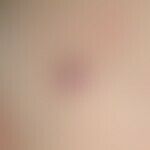Synonym(s)
DefinitionThis section has been translated automatically.
Flat, spherical or pointed conical efflorescence protruding above the skin, up to 1.0 cm in diameter (note: larger, raised efflorescences are called plaques or nodules ) Efflorescence of varying color, consistency and configuration. Their consistency ranges from soft, firm to hard (e.g. calcinosis cutis). Their surface may be smooth, rough or scaly. In a sectional pattern, papules present as flat, flat-oval, hemispherical, or pointed conical elevations.
General informationThis section has been translated automatically.
In the differential diagnostic classification of a skin disease, a distinction must be made between a solitary papule or between multiple papules as a partial symptom of a localized or generalized disease (e.g., papular exanthema in an adverse drug reaction or in a classic infectious disease). This distinction can be made by visual diagnosis in most cases. It is crucial for the further examination procedure (regional examination only or whole body examination). Other aspects that are important for visual diagnosis are the distribution pattern of a papular or maculo-papular exanthema, its dynamics and the assessment of the general condition.
You might also be interested in
DiagnosisThis section has been translated automatically.
In principle, numerous different clinical aspects must be considered and evaluated in the differential diagnostic evaluation of a skin disease defined by papules. These include:
- Size
- number and distribution (solitary, multiple, grouped, disseminated, exanthematous)
- Arrangement and shape (gyrate, herpetiform, serpiginous, in Blaschko lines, segmental, anular, polygonal, reticular)
- Structural and functional assignment (follicular, sweat glands, emphatically non-follicular (e.g., lichen planus), contact sites or defined by exogenous trigger (e.g., plant contact (e.g., meadow grass dermatitis), heliotrope, random, textile-covered (e.g., scabies)
- Topographic assignment (different body regions, field skin, groin skin, face, nose, auricle, capillitium, intertriginous)
- Boundary (sharp-edged, fuzzy, scalloped, jagged, random)
- color (dull red, light red, deep red, hemorrhagic, transition to purpura, blue-red)
- surface texture (smooth, keratotic, eroded, crusty)
- temperature (hypo-, normo-, hyperthermic)
- Consistency (unchanged, slightly to moderately increased [palpable erythema]/transition to papule)
- Symptomatology (absent, mild itching, severe itching, burning itching, pain)
- association with fever and/or other general symptoms (arthralgias, intestinal symptoms, fatigue)
- Association with metabolic diseases (les papules dysmétabolique par accumulation des substances amorphes), pregnancy, malignant tumors, autoimmune diseases
- Dynamics (static, acute volatile, acute persistent, chronic persistent, crescendo reaction with increasing dynamics, wave dynamics, with increasing phase plateau phase and decrescendo phase).
- Triggering: Exogenous triggering: Physical: cold,heat, pressure, UV, light), biochemical (exertion; water; irritants), allergic (contact allergens).
- Triggering: Endogenous triggering: bacterial, viral, mycotic infections, UAW (drug reactions), food allergies.
Note(s)This section has been translated automatically.
A papule (substance proliferation-persistent) is not an urticum (dermal edema-volatile).
LiteratureThis section has been translated automatically.
- Altmeyer P (2007) Dermatological differential diagnosis. The way to clinical diagnosis. Springer Medicine Publishing House, Heidelberg
- Nast A, Griffiths CE, Hay R, Sterry W, Bolognia JL. The 2016 International League of Dermatological Societies' revised glossary for the description of cutaneous lesions. Br J Dermatol. 174:1351-1358.
Ochsendorf F et al (2017) Examination procedure and theory of efflorescence. Dermatologist 68: 229-242

























